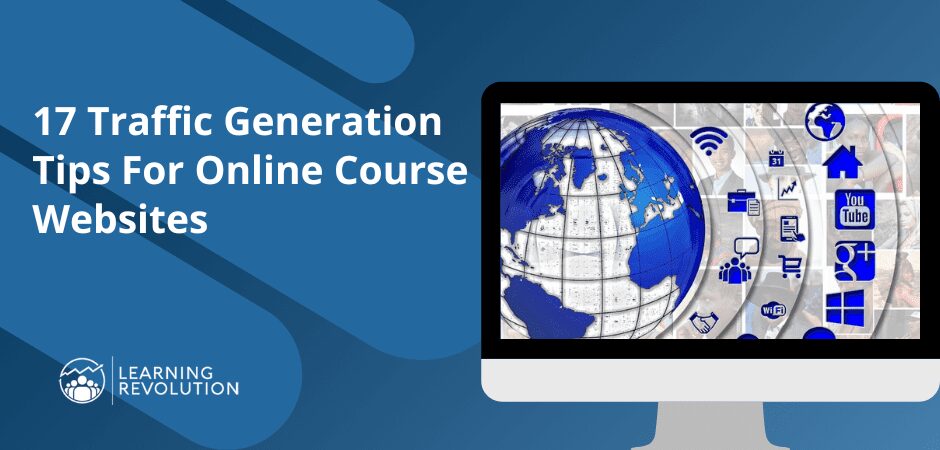

Online masterclasses can be great fun, but they’re also a lot of work. From finding the right platform and writing the class, to selling spots and getting reviews, a lot of moving parts need to come together seamlessly in order to make the masterclass a success.
This undertaking might seem daunting, and many edupreneurs are put off by the initial investment in time (and money) that a masterclass requires. However, masterclasses can repay educators in increased revenue, improved reputation, and by attracting new learners who remain loyal to that educator for years to come.
Asking yourself some key questions, and breaking down each stage of planning into small, manageable tasks, will allow you to plan a masterclass that comes together effortlessly.
Note: If you are not clear on what a masterclass is, you may want to read this post first.
Why do you want to run a masterclass?
This is an important question to answer, because it will inform all the other aspects of your masterclass.
If you want to try something new, have fun, and engage with dedicated learners—great! You don’t have to worry too much about profits and that means keeping it simple. You could host your masterclass via social media or and don’t have to worry about conferencing software, creating slideshows and graphics, or creating a “wow factor.” Cheap and cheerful is a fantastic way to test the water and ensure your masterclass is accessible to anyone who wants to learn.
However if your plan for your masterclass is to open up a new revenue stream, profits do matter. That means producing a masterclass that learners will be happy to pay a premium to attend. These masterclasses require more reliable hosting software and “value added” extras such as promotional materials and one-on-one attention.
Maybe you want to boost your professional reputation by holding a masterclass, in which case you’ll walk a line between the above extremes. Your audience will matter most in this instance, as you’ll want to attract advanced learners who are already considered authorities themselves.
Your reasons for running a masterclass can be varied and nuanced, but understanding exactly what you want to get from the experience will help you plan for success.
What will learners get from your masterclass?
The second question to consider is what value proposition your masterclass offers to your learners. Will they master a new hobby, learn a skill that will advance their career or improve their quality of life, or simply learn more about a subject that interests them? Just like with your reasons for hosting a masterclass, learners’ goals can vary wildly, and there are no right or wrong answers. However the value proposition of your masterclass will inform the sort of learners you attract and the price tag you can attach to it.
That isn’t to say you can’t make a casual or interest-based masterclass profitable. Thousands of people sign up for classes, courses, and even degrees every year for the simple pleasure of learning. However you must tailor your masterclass’s desired outcome to the learners you want to attract. You won’t get many college students signing up for a four-figure masterclass on HR policy and people management. Equally, a free masterclass on ancient philosophy probably won’t attract many C-suite executives.
Learners consider masterclasses in a variety of lights, including time and financial constraints, personal interest, and ongoing benefit. For an executive, time is more valuable than money, so you can charge a premium to teach these learners. A masterclass might even be more likely to appeal to learners of this type because of its condensed, intensive nature. Students and lower income learners will often weigh the financial cost of a masterclass as more important than its length. You’ll appeal best to these learners with an online course that takes longer to complete but costs less to attend.
Don’t underestimate the power of personal interest. Not every masterclass has to teach an important life or business skill, or have a direct impact on the learners’ employability, datability, or other social/financial metric. Most people can paint just a little, but very few will ever make money from doing so, even if they’re exceptionally talented. Yet art masterclasses are enduringly popular, despite the knowledge they impart being functionally useless to most attendees. Learning for its own sake can be sufficient reward for many people, so don’t fall into the trap of devaluing your masterclass because you don’t feel the outcome is prestigious enough.
What you should do is clearly define your learners’ outcome goal and stand by it, no matter what. Whether you’re planning to revolutionize lives or give learners the ability to create a fun painting, as long as your value proposition is clear, learners can choose for themselves if they consider the price fair.
Identifying learners for your masterclass
Once you have defined your aim in running a masterclass and your intended learner outcomes, you should be able to narrow down who your target learners are. Start with broad strokes—is your ideal learner male or female, old or young, low or high income. Then use your aims to further define your learner profile. Are they new to your subject or already established students? Do they work in a particular industry, or keep similar hours?
As you answer these questions, your learner profile will become more specific, enabling you to pinpoint the best ways to attract their attention and tailor your masterclass to their requirements. The duration and price of your masterclass depend on your learners’ time and financial availability, which often have an inverse relationship to each other.
There will also be good and bad times to host your masterclass. Student learners might have more free time on weekends than working parents, while business-oriented masterclasses will only fare well during workdays if your value proposition is something learners can convince their employers is worth time off to acquire.
Think about work schedules, term dates, and public holidays, as well as the needs of your particular learners. A masterclass held in early December will suffer because the holidays put a lot of demands on people’s time and money. Equally in the middle of summer schools are out and parents could struggle with childcare.
Getting the basics of your masterclass right
In order to prepare for success, you should plan the details of your masterclass with an eye toward the learners you intend to attract. Understanding who your learners are is vital to establishing their availability and financial constraints. You can then apply this knowledge when you’re choosing a date, time, hosting service, and price for your masterclass.
Example A
A masterclass aimed at college students
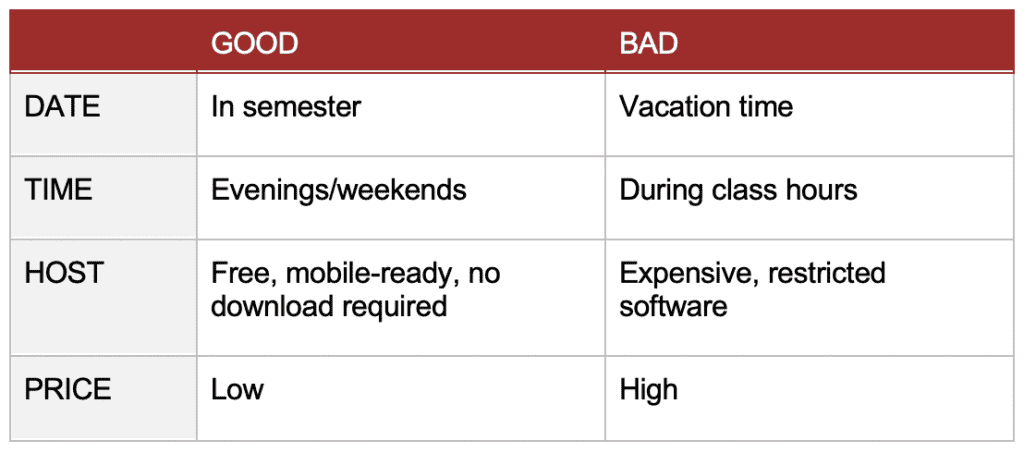

Example B
A masterclass aimed at low-income working parents
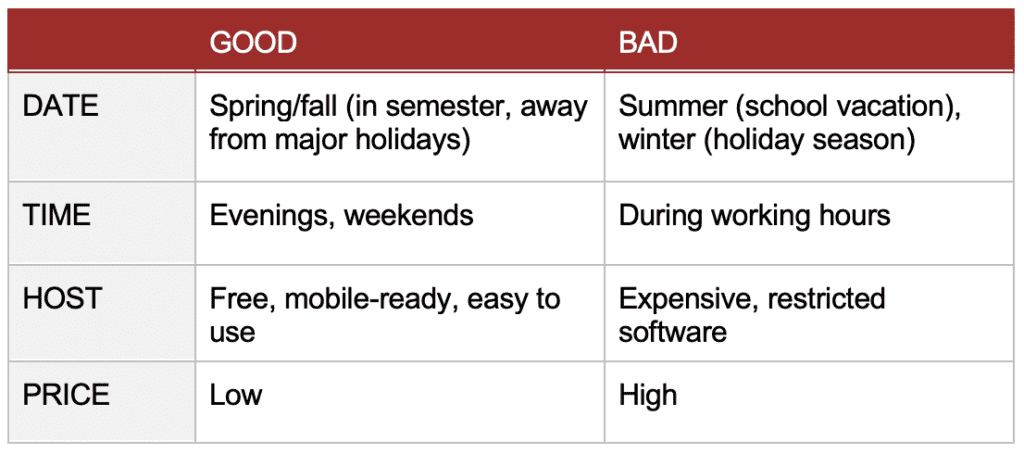

Example C
A masterclass aimed at business executives (teaching business skills)
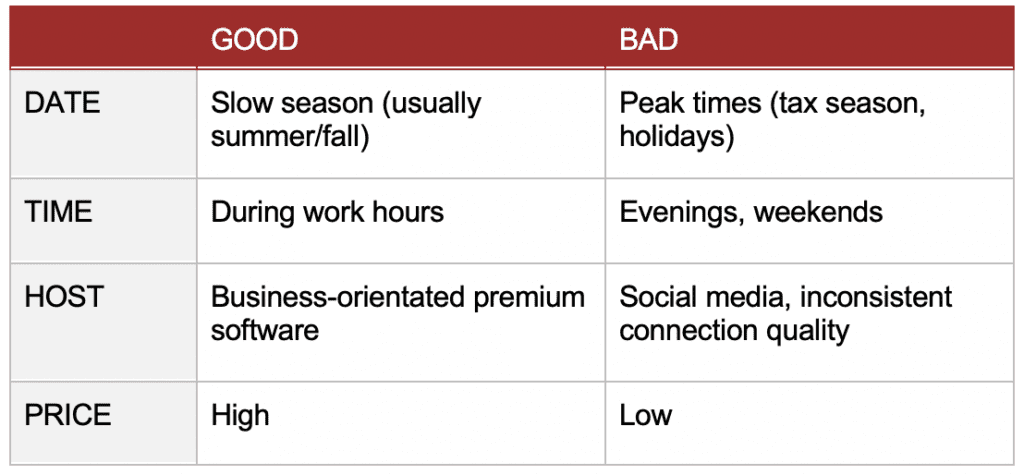

Example D
A masterclass aimed at blue collar small business owners
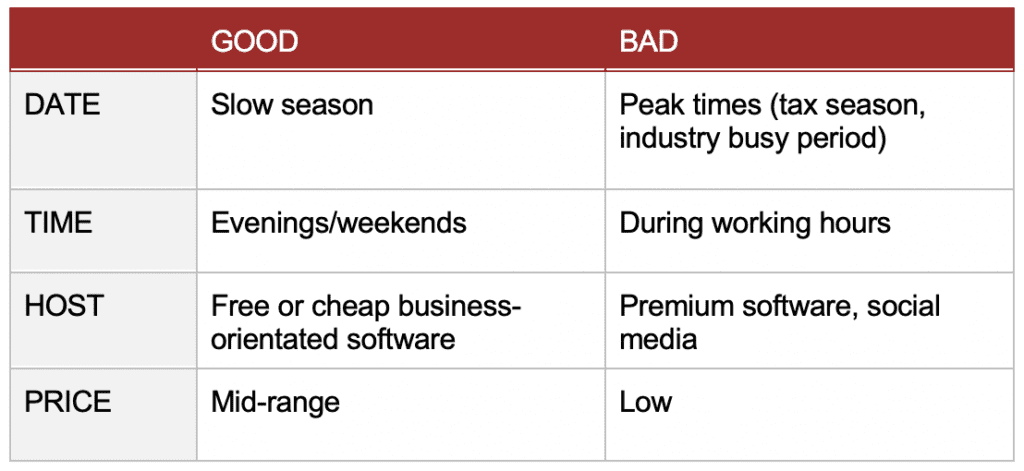

Example E
A masterclass aimed at retirees
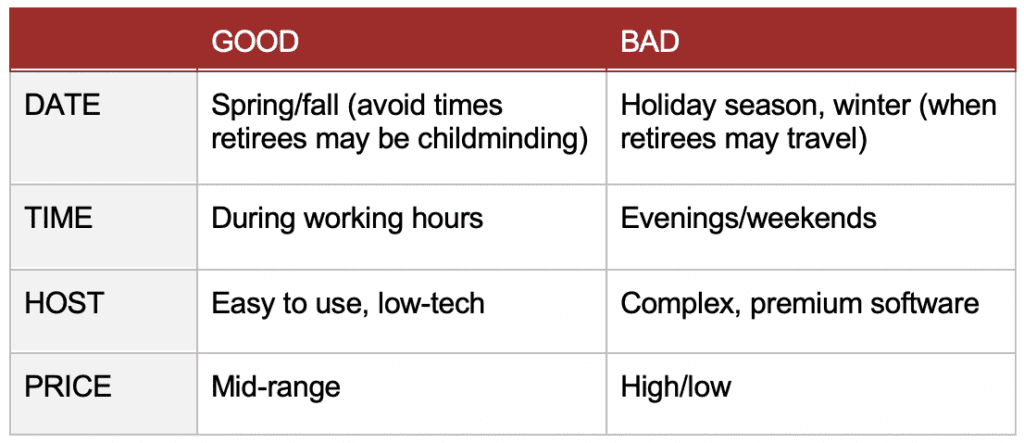

The duration of your masterclass is another key consideration. The first and most important factor when determining this is the outcome you want your learners to attain. A masterclass on oil painting might be completed in under an hour (the time it takes you to produce a painting), whereas a masterclass on business skills might take several hours to cover.
Weigh the importance of the outcome with the anticipated availability of your learners. If you need longer to teach your class than your learners have time to attend, revisit your value proposition. Can you break it down into a smaller, more attainable goal that will still be appealing to learners, and is also tailored to fit their schedule?
In the early planning stage, don’t become too firmly attached to a single idea, be it the subject, duration, price, or host of your masterclass. Ideally all these elements should be flexible enough that you can design a masterclass that will satisfy your reasons for hosting it, as well as appeal to the largest possible number of learners.
Don’t be afraid to poll learners on what they want. No amount of brainstorming can compensate for real opinions from the people you intend to teach. Float the idea through social media, your website and/or mailing list, or existing courses to discover what the majority find the most attractive proposition.
How to choose video streaming for your masterclass
Once you’ve decided on the basics, it’s time to search for the perfect host for your masterclass. There are plenty to choose from, from social media live broadcasts to dedicated business conferencing services. (And, you can tie these options together and provide other content – e.g., readings, quizzes, discussion forums – by using an online course platform.)
Take your first cues from your learners. Business learners will prefer established conferencing platforms with good connectivity and a range of add-ons such as screen splitting, company branding, and admin dashboards. College students might prefer free, mobile-ready options such as Facebook Live.
Price is an important factor. The lower your costs, the sooner your masterclass will turn a profit. This is particularly important if you want to attract low-income learners, or if money is a secondary concern to you and you simply want to cover your expenses. Premium software comes with a premium price tag. Often streaming services limit the number of attendees on a single line, which could help you determine the size of your masterclass and how to limit availability. For instance the price for a Zoom conference rises sharply for any event with over 100 attendees, and Skype for Business caps out at 250 attendees.
There are less constraints on attendees/viewers with social media streaming, but the downside is poorer connectivity and less control over how you present your masterclass. Nonetheless, low-income and younger learners might be happy to compromise. Social streaming is also mobile-ready and doesn’t require any software downloads, making it more accessible to greater numbers of learners.
Finally, think about the feel and tone of your chosen host. Does it fit the subject of your masterclass? What does the streaming service you use suggest about the class teacher, attendees, and structure? Even if you think your host is perfect, be sure your learners think so too.
How to write a masterclass
For most edupreneurs, writing the lessons can be the toughest part. The good news is masterclasses aren’t lectures, so you’re unlikely to need to memorize a long speech. Instead, break down the subject of your masterclass and consider the steps you need to take to guide your learners toward achieving their goal.
Framing your masterclass as a series of logical steps is a great way to keep on track while you’re teaching by giving you a clear outline to follow. Whether you’re sure you can remember everything or know you’ll need prompts, a series of flashcards is useful to guide you if you lose your place or the discussion strays from your projected class outline.
Also consider using presentations to illustrate your masterclass. A PowerPoint deck or similar resource can also serve as a memory aid, and gives learners something to focus on as you’re talking.
Remember to consider the media capabilities of the streaming service you choose before you make a presentation or decide to reply on photo and video slides to keep you on track. Some hosts will include screen sharing functionality, while others charge a premium or don’t offer that service at all.
Keep your capabilities in mind as well when you’re creating prompt materials to share with the masterclass. Younger learners attending a cheap class probably won’t care if your materials are a bit rough and ready, but for a high-priced and/or corporate masterclass, you’ll need to give a presentation that’s as good as anything learners would expect to see in the boardroom. If you lack the time or skills to produce quality material, hiring a graphic designer could be an unexpected expense you have to cover.
Creating detailed outlines
It might not be necessary to use a detailed outline if you’re teaching a short or hands-on masterclass, but if you’re planning a class that will last several hours, breaking lessons down into short segments will make it easier to keep your masterclass on schedule.
Not all of the time spent in your masterclass will involve you speaking. Remember to leave space for learners to ask questions and discuss the materials. Allowing learners to engage with each new lesson will cement their learning and bolster their understanding of your masterclass. If your masterclass is expected to last longer than one or two hours it’s also a good idea to include a break to allow your learners time to decompress.
Paced outlines also help you if something goes wrong and your masterclass gets off track, by giving you check-in points to ensure you’re keeping to schedule. By keeping an eye on the clock as your masterclass is underway, you can determine very quickly if you’re going too fast, too slow, or straying too far from your original subject.
Providing takeaway materials for your masterclass
If you use a presentation or visual aids during your masterclass, it’s a great idea to send out electronic copies to attendees either before or after the class takes place. Providing a copy of your presentation materials or a summary of the masterclass can help learners who want to revisit the class at home in their own time and ensure they fully understood everything you taught.
Space within distributed materials could also be used for advertising and promotion if you secure a sponsor for your class. If you have other products available, such as a book or ecourse, don’t forget to include links within your handouts!
Keeping in touch with your learners
Once your masterclass is complete, you should try to keep in touch with your learners. They’ve already demonstrated a commitment to your and your teaching, and are the most likely to purchase another lesson from you in future. They’re also your best source of word-of-mouth promotion about your masterclass as they speak to their friends and social networks.
When learners sign up for your masterclass, you should collect their name and email address as a minimum. Curating a mailing list just for masterclass learners makes the content feel more exclusive, and the learners feel singled out for more attention. You can also create masterclass alumni social media groups, provide access to restricted areas on your website, or think of other ways of making your masterclass participants stand out from other learners. Creating this atmosphere of exclusivity encourages the desire of others to join, making your next masterclass more marketable.
Getting honest feedback is also important, especially if this was your first masterclass. Listen with an open mind to the opinions of your learners and they can help you improve your teaching in the future. Take criticism as an opportunity to solve a problem: for instance if learners complained that you mumbled, you’ll know next time to invest in a better microphone or hosting software.
Running a masterclass might seem like a big undertaking, but if you break it down into smaller tasks and approach each one in a logical fashion, you can build a class that will truly appeal to your learners, boost your reputation as an edupreneur, and continue to earn revenue for years to come.
See also:
Table of Contents
